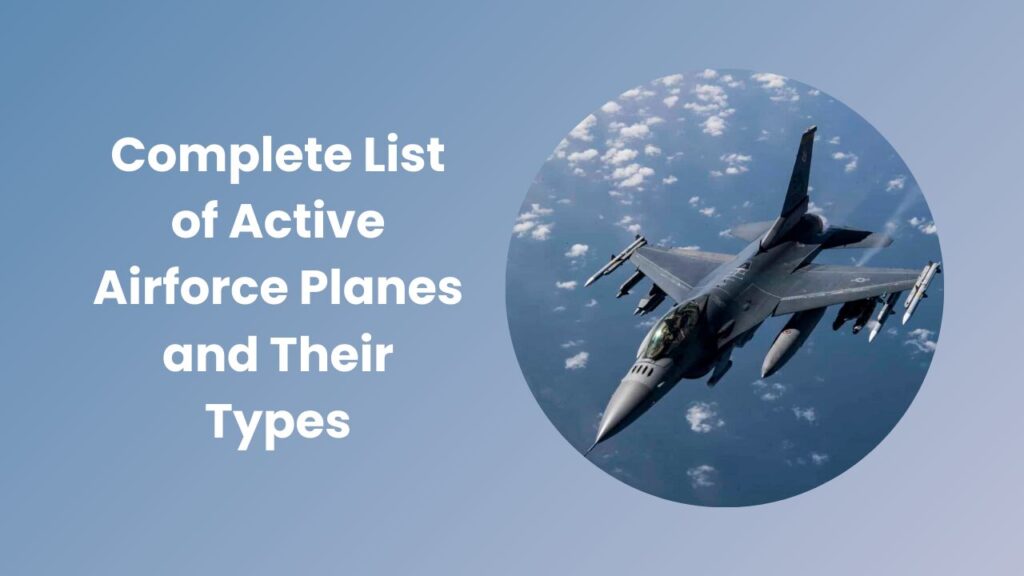The strength of any air force lies not only in the number of aircraft it possesses but also in the versatility, efficiency, and technological sophistication of each plane in its fleet. Understanding the list of airforce planes provides valuable insight into how nations maintain robust aerial defense systems, conduct complex strategic missions, and ensure that pilots are trained to operate under a wide variety of conditions. Every aircraft in service fulfills a specific and critical role, whether it is designed for high-speed combat, reconnaissance and intelligence gathering, transporting troops and equipment, or providing essential pilot training. The combination of these aircraft creates a carefully balanced fleet capable of addressing both defensive and offensive operations while adapting to rapidly changing scenarios in modern warfare. This article delves into the diverse and meticulously maintained fleet of the Pakistan Air Force (PAF), offering detailed descriptions of each aircraft type, their operational capabilities, technological features, and the significant contributions they make toward ensuring national security and maintaining air superiority in the region.
List of airforce planes
Fighter Aircraft
Fighter aircraft form the backbone of any air force, tasked with air superiority, interception, and precision strike missions. The Pakistan Air Force maintains a robust fleet of fighters, combining modern technology with proven combat platforms.
JF-17 Thunder
The JF-17 Thunder is a lightweight, multirole fighter jointly developed by Pakistan and China. Known for its agility, modern avionics, and advanced radar systems, the JF-17 can perform air-to-air and air-to-ground missions efficiently. Equipped with a range of precision-guided munitions, it provides both offensive and defensive capabilities. Its versatility allows the PAF to deploy it for interception, ground support, and reconnaissance operations. The aircraft’s relatively low operating cost and ease of maintenance make it an ideal solution for modern aerial warfare. The JF-17 has undergone several upgrades, enhancing its radar, electronic warfare systems, and weapon payload.
F-16 Fighting Falcon
The F-16 Fighting Falcon is a highly maneuverable, multirole fighter acquired by Pakistan from the United States. It is equipped with sophisticated avionics, radar, and targeting systems capable of engaging multiple threats simultaneously. The F-16 serves both air defense and strike roles, providing long-range strike capabilities and superior aerial agility. With a maximum speed exceeding Mach 2, it can perform rapid interception missions while maintaining precision in combat. Regular upgrades in avionics and weapon systems keep it competitive with modern threats. The F-16 remains one of the most recognized and versatile aircraft in the PAF fleet.
Mirage III & Mirage V
The Mirage III and Mirage V are classic French-origin fighter aircraft that have served Pakistan for decades. Mirage III primarily performs high-speed interception missions, while Mirage V focuses on ground attack and tactical bombing. Both aircraft are equipped with advanced avionics, radar, and weapons systems suitable for combat and reconnaissance missions. Despite being older platforms, continuous upgrades have maintained their operational relevance. Their lightweight design and high-speed capabilities make them effective for rapid response and strike missions. These aircraft continue to complement the PAF’s modern fighters in maintaining air superiority and strategic deterrence.
Chengdu J-7
The Chengdu J-7 is a lightweight, supersonic fighter adapted from the MiG-21 design. It is primarily used for air defense and pilot training missions. The J-7 combines speed and agility, making it effective for interception operations. While older than modern platforms, it remains operational due to continuous maintenance and system upgrades. Its relatively low cost allows the PAF to deploy it in secondary combat roles and training missions. The aircraft also contributes to maintaining a diverse fighter fleet capable of responding to multiple operational scenarios.
Mirage 5PA
The Mirage 5PA is a ground-attack variant of the Mirage series, optimized for precision bombing and close air support. Equipped with specialized avionics and targeting systems, it can deliver a range of guided and unguided munitions. Its high-speed performance allows for rapid strike missions, making it effective in tactical operations. Continuous upgrades to radar and electronic systems enhance its survivability in hostile environments. The Mirage 5PA provides an essential balance to the PAF’s fleet by focusing on ground-attack missions alongside modern multirole fighters.
Trainer Aircraft
Trainer aircraft are essential for developing skilled pilots capable of handling advanced combat and operational aircraft. The Pakistan Air Force operates several types of trainers to provide comprehensive flight training.
K-8 Karakorum
The K-8 Karakorum is a jet trainer developed jointly by Pakistan and China. It combines modern avionics with reliable performance, preparing pilots for fast jets and combat missions. The aircraft allows for training in basic and advanced flight techniques, navigation, and weapon deployment. Its versatility ensures that pilots gain operational experience without the risks associated with frontline combat aircraft. The K-8 also supports light attack roles, making it a practical platform for both training and operational use. Its durable design and ease of maintenance contribute to efficient pilot training programs.
MFI-17 Mushshak
The MFI-17 Mushshak is a primary trainer used extensively for basic flight training. Its simple design, low operating cost, and reliable performance make it ideal for introducing new pilots to flying principles. The Mushshak helps pilots master takeoffs, landings, and fundamental aerial maneuvers before transitioning to jet trainers or combat aircraft. It also supports light reconnaissance and observation missions in certain operational contexts. By providing a solid foundation, the MFI-17 ensures pilots are ready to progress safely and effectively through the ranks of advanced air training programs.
T-37 Tweet
The T-37 Tweet is a small jet trainer that has been used for advanced pilot instruction. It enables trainee pilots to practice high-speed maneuvers, aerobatics, and basic combat techniques. With its simple cockpit layout and responsive controls, the T-37 is ideal for preparing pilots to transition to faster, more complex fighter jets. It also helps in teaching formation flying, navigation, and instrument proficiency, ensuring that pilots develop comprehensive operational skills before entering frontline units.
Super Mushshak
The Super Mushshak is a modernized version of the MFI-17, featuring upgraded avionics, improved engine performance, and enhanced safety systems. It provides an efficient training platform for basic flight instruction while supporting limited light attack and surveillance roles. Its advanced technology helps bridge the gap between primary training and operational jet aircraft, ensuring that pilots gain a thorough understanding of contemporary flight systems and mission capabilities.
Transport Aircraft
Transport aircraft are crucial for logistical support, troop movement, humanitarian missions, and strategic mobility. The Pakistan Air Force operates several transport platforms to maintain operational readiness across diverse terrains.
C-130 Hercules
The C-130 Hercules is a highly versatile transport aircraft capable of performing tactical airlift, medical evacuation, and cargo missions. Its rugged design allows operations from short and unprepared airstrips, making it invaluable in challenging environments. The aircraft supports troop deployment, humanitarian aid delivery, and disaster relief operations. With a large cargo hold and long-range capabilities, the C-130 ensures rapid and flexible logistical support for military operations. Its reliability and proven performance have made it a cornerstone of the PAF’s transport fleet.
Il-78 Midas
The Il-78 Midas is an aerial refueling aircraft that extends the operational range of fighter jets and other aircraft. Its strategic importance lies in supporting long-duration missions and enhancing the reach of the PAF’s combat and reconnaissance aircraft. By enabling mid-air refueling, the Il-78 allows fighters to remain in the operational area for extended periods, providing sustained air superiority and strike capability. The aircraft also carries cargo and personnel, adding to its versatility. Its presence ensures that Pakistan’s air operations can cover vast distances without compromising mission effectiveness.
CN-235
The CN-235 is a medium-lift transport aircraft used for tactical airlift and logistical operations. Its ability to operate from short and semi-prepared airstrips makes it suitable for regional deployment and humanitarian missions. The aircraft can carry troops, cargo, and equipment over moderate distances efficiently. Its design allows for easy maintenance and operational flexibility, which is essential for rapid response during military operations or disaster relief scenarios.
An-32
The An-32 is a rugged transport aircraft capable of operating in challenging conditions, including high-altitude and mountainous regions. It is used for troop movement, cargo delivery, and logistical support in areas where other aircraft may face limitations. Its reliability in adverse weather and rough terrain enhances the PAF’s operational reach. The An-32 ensures that critical missions can continue uninterrupted, supporting both military and humanitarian objectives.
Special Aircraft
Special aircraft, including airborne early warning and control systems, electronic warfare platforms, and reconnaissance planes, provide advanced capabilities that enhance situational awareness and operational efficiency.
AWACS & Radar Planes
Airborne Warning and Control System (AWACS) aircraft are equipped with advanced radar and communication systems that detect, track, and manage multiple aerial threats simultaneously. These aircraft act as flying command centers, guiding fighters during combat, monitoring airspace, and coordinating missions. Electronic warfare planes support offensive and defensive operations by jamming enemy communications and radar systems. Reconnaissance aircraft gather intelligence, monitor borders, and provide actionable data for decision-making. The integration of these special aircraft ensures the PAF maintains technological superiority, operational readiness, and strategic flexibility.
Saab 2000 AEW&C
The Saab 2000 AEW&C is a modern airborne early warning platform providing long-range radar surveillance, threat detection, and command and control capabilities. It enhances situational awareness across Pakistan’s airspace and supports coordination among fighter and transport aircraft. Equipped with advanced sensors, the Saab 2000 can identify multiple targets simultaneously, offering early warning and strategic operational planning. Its role is critical for maintaining air superiority and enhancing the effectiveness of the PAF’s aerial operations.
Sea King Helicopter
The Sea King is a multi-role helicopter capable of performing search and rescue, maritime patrol, and transport missions. Its versatility allows the PAF to operate in both land and sea environments, supporting humanitarian and operational objectives. Equipped with advanced navigation and communication systems, the Sea King ensures safe operations even in challenging conditions. Its ability to perform reconnaissance and limited combat roles adds to the fleet’s overall operational flexibility.
Conclusion
The list of airforce planes in the Pakistan Air Force reflects a balance between modern technology, proven combat platforms, and strategic versatility. From advanced multirole fighters like the JF-17 and F-16 to essential trainers, rugged transport aircraft, and specialized AWACS platforms, each plane contributes uniquely to national defense. By maintaining a diverse fleet, Pakistan ensures operational readiness across multiple scenarios, ranging from high-intensity conflict to humanitarian assistance. Understanding this fleet highlights the importance of investing in technology, pilot training, and strategic aircraft to uphold national security and air superiority. The PAF’s combination of advanced fighters, capable trainers, and multi-role support aircraft ensures that Pakistan remains prepared to face evolving challenges in the skies.
FAQs
How many types of aircraft are in the Pakistan Air Force?
The Pakistan Air Force operates several types of aircraft, including fighter jets, trainers, transport planes, helicopters, and special mission aircraft. Each serves a specific role to maintain operational readiness and strategic capabilities.
Which is the most advanced fighter plane in Pakistan?
The JF-17 Thunder, with modern avionics, precision-guided weapons, and multi-role capability, is considered the most advanced indigenous fighter in Pakistan.
How are trainer aircraft important for air force operations?
Trainer aircraft, such as the K-8 Karakorum, T-37 Tweet, and MFI-17 Mushshak, are essential for preparing pilots to handle advanced combat aircraft safely and effectively. They provide foundational flight skills, tactical knowledge, and operational readiness for frontline duties.
What role do transport aircraft play in the air force?
Transport aircraft like the C-130 Hercules, CN-235, and An-32 are crucial for troop movement, cargo delivery, humanitarian missions, and strategic mobility. They ensure rapid and flexible logistical support for military operations.





